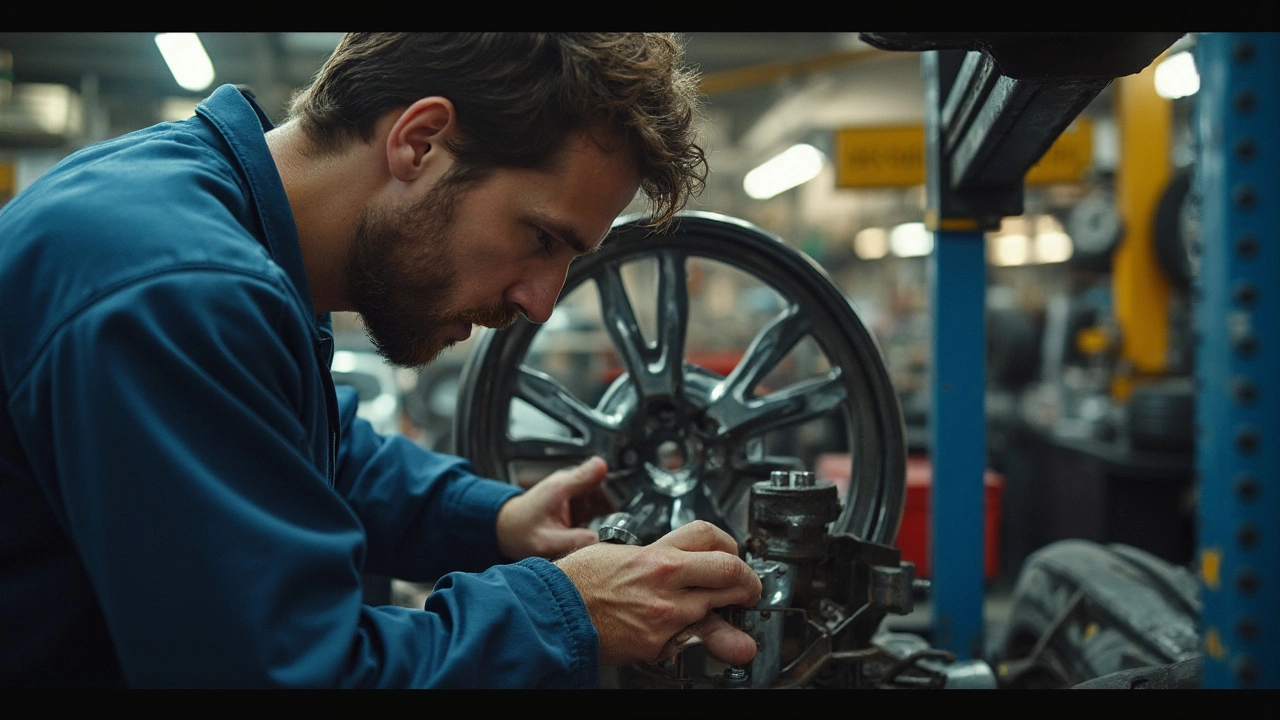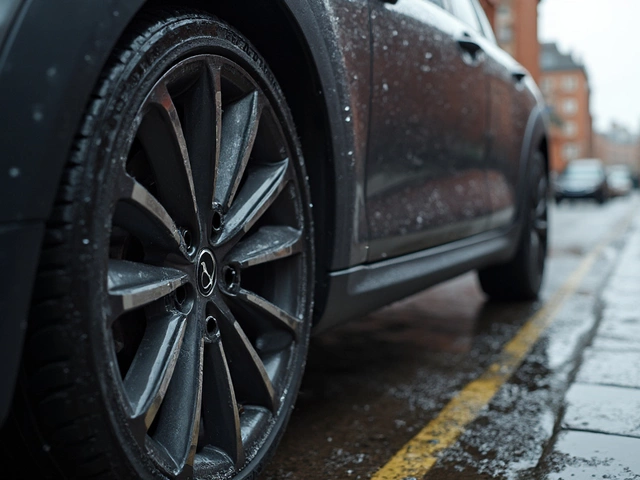Ever felt your steering wheel vibrate or your car wobbles strangely, especially at higher speeds? That's a sign your wheels might be out of balance. For alloy wheel enthusiasts, this is something worth paying attention to. Alloy wheels, with their sleek designs and lightweight nature, often require more attentive maintenance compared to their steel counterparts.
So, do alloy wheels need to be balanced? Absolutely! Just like any other wheels, alloy wheels must be balanced to ensure safe and smooth driving. When you balance your wheels, it's all about equalizing the weight distribution around your car's axle. It's not just about comfort—imbalanced wheels can affect your vehicle's safety, tire longevity, and even fuel efficiency.
Here's a quick nugget: If you've recently purchased new alloy wheels or tires, or if you've hit a pothole a bit too hard, getting your wheels checked for balance is not only wise but necessary.
- Understanding Wheel Balancing
- Signs Your Wheels Are Out of Balance
- Why Balancing Matters
- How It's Done: The Balancing Process
- Consequences of Skipping Balancing
- Tips for Maintaining Balanced Wheels
Understanding Wheel Balancing
Wheel balancing might sound fancy, but it's basically just making sure the weight of your wheels is distributed evenly. When you buy a brand-new car or change to fresh alloy wheels or tires, having perfectly balanced wheels ensures a smooth ride. It's especially important for alloy wheels, given their light and elegant designs.
Why does balance matter? When wheels aren't balanced, they can cause uneven tire wear, vibrations, and even affect your vehicle's alignment. In simple terms, unbalanced wheels mean parts of your tire are getting more wear and tear, which can lead to needing new tires sooner than you'd like.
How is Wheel Balancing Done?
The process of balancing involves a technician placing your alloy wheels on a machine called a wheel balancer. This machine spins the wheel to detect any imbalance.
Here's a quick step-by-step:
- The wheel is mounted on the machine.
- The machine spins the wheel to measure vibration.
- Technicians identify where the imbalance is.
- They adjust it by adding small weights to the wheel's rim.
Once those weights are added, your wheels are set to give you a smoother drive. Think of it like perfectly adjusting your backpack so it doesn't pull on one shoulder!
Balancing Frequency
Here's an interesting tidbit: it's recommended to check your wheel balance every time you rotate your tires or at least every 6,000 to 8,000 miles. Regular checks can really help in maintaining vehicle safety and performance.
There’s a lot to gain from just spending a little time and money on balancing. Letting this slip can lead to more expensive issues down the line!
| Issue | Consequence |
|---|---|
| Uneven Tire Wear | Reduced tire life |
| Vibrations | Uncomfortable driving |
| Alignment Issues | Poor vehicle handling |
Signs Your Wheels Are Out of Balance
Noticing something off with your car lately? Maybe it's got a bit of a shake or a shimmy? These might be classic signs that your wheel balancing is out of whack. Let's dive into some common symptoms that say it's time to get those alloy wheels checked.
Vibrations While Driving
Vibrations are like the universal sign for wheel imbalance. You’ll often feel it through the steering wheel, especially if you’re cruising at speeds above 50 mph. It might start as a slight wobble and grow into a full-blown shake. If the steering wheel's doing a tango, there's a good chance wheel imbalance is to blame.
Uneven Tire Wear
Keep an eye out for weird patterns on your tires. If one side is wearing down way faster than the other, your wheels might not be balanced. Over time, this can really eat into your tires' lifespan, and let’s face it, nobody wants to fork out extra cash for tires sooner than needed.
Noisy Ride
Your car should hum along nicely. But if there's humming, buzzing, or any unsettled sound coming from underneath, imbalanced wheels could be the culprit. Those noises aren't just annoying—they're a sign something's not right.
Poor Fuel Economy
Not the first thing that comes to mind, right? But poorly balanced wheels can actually lower your fuel efficiency. With your car fighting itself due to imbalance, it's working harder than it needs to, burning more fuel in the process.
Steering and Handling Issues
Ever feel like you’re wrestling with your steering wheel? Imbalance in your alloy wheels can make your vehicle pull to one side, making smooth driving and quick maneuvers tough.
Summary of Symptoms
| Symptom | Impact |
|---|---|
| Vibrations | Shaky steering, uncomfortable ride |
| Uneven Tire Wear | Shortens tire life |
| Noisy Ride | Louder than usual, distracting |
| Poor Fuel Economy | Higher fuel costs |
| Steering Issues | Poor handling, harder to control |
Now that you know the signs, don't ignore them. If your car is showing any of these symptoms, it might be time to head to your local auto shop and get those wheels balanced.
Why Balancing Matters
When it comes to maintaining your car's performance and safety, wheel balancing is a key task. It's not just about keeping things smooth and comfortable; it's about taking care of your vehicle in a more comprehensive way. Let's explore why this simple maintenance step is critical.
Improves Vehicle Handling
Properly balanced wheels are essential for optimal handling of your vehicle. Uneven weight distribution can lead to vibrations, especially at higher speeds, which can make steering challenging. These vibrations can transfer to the steering wheel, causing discomfort for the driver and potentially leading to unsafe driving conditions.
Enhances Tire Longevity
No one likes to replace tires more often than needed. Regularly balancing your alloy wheels can significantly extend the life of your tires. When wheels aren't balanced, they can cause uneven wear on tires, which means you'll be heading to the shop for new tires much sooner than you'd like.
Boosts Fuel Efficiency
Believe it or not, having balanced wheels can actually help you get more miles to the gallon. Imbalanced wheels create resistance and drag, forcing your engine to work harder and burn more fuel. By ensuring your wheels are balanced, you can keep that gas guzzling at bay and save some cash at the pump.
Protects Suspension Components
Your vehicle's suspension system works best when all parts are in harmony. Imbalanced wheels can place additional strain on the suspension and alignment, leading to more wear and potentially costly repairs. Keeping your wheels balanced helps distribute stress evenly across the system, protecting those vital components
Keeping these factors in mind, it's clear that balancing your alloy wheels isn't just about minimizing vibrations; it's about maintaining the overall health of your car. So next time your car is in for a check-up, make sure wheel balancing is part of the agenda.

How It's Done: The Balancing Process
Wheel balancing might sound complicated, but it’s a straightforward process when done by pros. It all starts with removing the wheel and tire from your car. The mechanic then mounts it onto a balancing machine, which spins the assembly to measure the vibration. This is how they find the imbalance.
Balancing Equipment and Techniques
Modern balancing machines are quite nifty. They pinpoint exactly where the weight needs adjustment. The machine displays the imbalance on both the inner and outer sides of the wheel.
- First, the technician cleans the wheel to remove any debris that might throw off the measurements.
- The wheel is placed on the machine. As it spins, the machine’s sensors do their thing, calculating the point of imbalance.
- Small weights, usually made of lead or steel, are then clipped onto the wheel. These weights help balance out the wheels by offsetting the heavy spots.
- If the machine shows an optimal balance, the wheels are good to go. If not, it’s a rinse and repeat until things are smooth.
Balancing isn’t a one-time thing. Every so often, especially after fitting new alloy wheels or after experiencing a rough ride, a re-balance might be in order.
Spotting DIY Balancing At Home
While it’s usually best left to professionals, some folks like to try a bit of DIY balancing. This often involves a simple bubble balancer, which is far less accurate than what you’d find at a shop but can still give you some insights if pro help is far away.
Curious about numbers? Here’s a fun fact: An imbalanced wheel can lead to vibrations at speeds over 40 mph but becomes especially noticeable at over 60 mph. Not balancing properly can speed up tire wear by as much as 20%.
Consequences of Skipping Balancing
Let's get real: ignoring wheel balancing can lead to some annoying and costly problems. You might think it’s no biggie, but here's why you should care. The wheel balancing procedure is like a health check-up for your alloy wheels.
1. Uneven Tire Wear
When your wheels aren't balanced, they wear out unevenly. Picture a bumpy tire constantly hitting the road—parts of the tire wear faster, and you'll end up buying new tires long before you want to. And trust me, tires aren't cheap!
2. Vibration Galore
Feel like your car's got a minor earthquake going on when you drive? That's a typical symptom of unbalanced alloy wheels. This isn't just uncomfortable; over time, it can cause more serious damage to your vehicle's suspension and steering components.
3. Poor Fuel Efficiency
Bet you didn’t think skipping a balancing could reach your fuel tank. Unbalanced tires make your car work harder to keep moving straight, which means burning more fuel. So, keeping those wheels balanced can actually save you gas money!
4. Safety Risks
Here's where it gets serious. Imbalanced wheels can affect your car's handling. You've got less grip on the road, which can be dangerous, especially in slick conditions.
5. Long-Term Vehicle Damage
The lasting effects on your car’s components shouldn’t be underestimated. Suspension systems, wheel bearings, and shocks can take a hit, leading to more frequent repairs and higher bills.
Turns out, car maintenance isn't just about keeping your ride pretty—it's about keeping everyone safe and your wallet intact.
Tips for Maintaining Balanced Wheels
Keeping your alloy wheels in peak condition is more than just an aesthetic choice. Well-balanced wheels can contribute to a safer, smoother ride, better fuel efficiency, and more importantly, prolonged tire life. Here are some practical tips you might want to consider:
Regular Check-Ups
Make it a habit to have your wheels checked every time you go for an oil change or routine vehicle maintenance. Many tire shops even offer free balance checks or charge a minimal fee. It's quick, easy, and worth it before those long road trips!
Be Mindful of Road Conditions
Those pesky potholes and speed bumps can throw your wheels off balance faster than you might think. Always try to avoid them if possible or approach them at low speeds to minimize impact. If you feel unusual vibrations afterwards, get your balance checked.
Rotate Your Tires
Regularly rotating your tires helps to ensure even wear and tear, which contributes to maintaining balanced wheels. Most vehicles recommend tire rotation every 5,000 to 8,000 miles. It’s a small effort that can lead to big savings on tires in the long run.
Balance When Changing Tires
Whenever you get new tires, it's a good idea to balance them immediately. This will help your new tires last longer and ensure a smoother ride right off the bat.
Stay Alert on the Road
If you start noticing irregular tire wear or unusual vibrations, don't ignore them. Trust your instincts and get those wheels re-checked. A quick visit to the shop can save you from a lot of trouble down the road.
And here's a little extra info: If you're into data, some studies suggest that keeping tires properly balanced can improve your fuel efficiency by up to 10%. Why not save some bucks at the pump while keeping safe?
| Frequency | Task |
|---|---|
| Every 5,000-8,000 miles | Rotate Tires |
| With every oil change | Align and balance wheels |
| After hitting a pothole | Check wheel balance |




